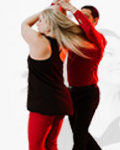What should you listen for in music? If all you know is the where to snap and the chorus line, you’re missing a lot!
NPR published 4 Ways to Hear More in Music, which is a great summary of the fundamentals of musical composition.
It’s worth reading the article itself for the example clips linked in the article, but if you want the cheat sheet, there are four elements mentioned in the article:
4 Things to Listen for in Music
- Rhythm and Meter
- Melody
- Harmony
- Color and Texture
As WCS dancers, we normally do a great job with rhythm and meter, and our community has learned a lot about melodic dancing with the increasing prominence of acoustic music.
Harmony and color and texture are trickier to learn. While you can pick up rhythm and melody as you listen through a song, hearing harmony requires the ability to listen to multiple sounds that happen at the same time within the song. More advanced dancers do a great job with some elements of harmony: listening for tonic chords, noticing dissonance and consonance, etc. But dancing color and texture are rare skills, because a lot of our music has the same instrument combinations.
To train yourself to hear color and texture, you really need to listen to a wide variety of music genres. Classical orchestra music is phenomenal because there are so many instruments, and classical composers are generally talented at featuring instruments on the basis of their sound quality. Or, you can start exploring instruments on YouTube: do a search for “[instrument] solo,” and listen to some of the clips for violin, trumpet, flute, clarinet, cello, and sax.
[mediacredit inline=”FALSE”]




 Brian & Megan
Brian & Megan